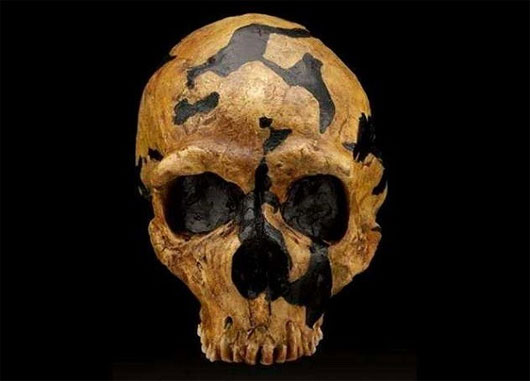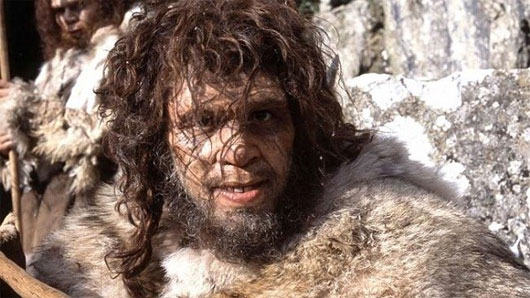Rare evidence of ancient carnivorous custom
Ancient meat eating is still one of the mysteries that scientists have been studying .
Few doubts, the murderous carnivorous practices have happened since humanity first appeared on Earth. Today, archaeologists find a great deal of evidence of sacrifices, revenge and even mass human flesh eating. They appeared from thousands, to tens of thousands of BC years.
1. Shanidar 3 (50,000 years BC)
In the Zagros Mountains in northern Iraq, archaeologists have dug a specimen of the Neanderthal murder, called 'Shanidar 3'. Through the survey, this specimen is a man about 40-50 years old, the cause of death is a stab wound in the rib No. 9.

Archaeologists have studied and hypothesized the death of this mysterious man. It is said that Neanderthals used long, heavy spears to hunt, mistaking Shanidar 3 as a target, so they spontaneously killed the man.

But many others think that this is the action of the hungry and modern people. Some evidence points out that modern people today eat Neanderthals.
The gas traces left on the Neanderthal jaw bone coincide with the tool used to split the remaining deer meat in Les Rois Cave - Southwest France. However, the real perpetrator of this death is still a mystery to archaeologists.
2. La Brea woman (7,000 years BC)
La Brea Lake in the southwestern island of Trinidad (USA) is a series of black liquid reservoirs, which harm many victims such as long-tailed tigers, emperor mammoths, and humans.
Among them, many researchers could not help but remember the body of the woman pulled out of the black pig in 1914. Scientists named the land La Brea named the remains of the woman there.

She was determined to live around 7,000 BC. Through the study, archaeologists determined that she was about 1.42m tall, with many cracks of heavy cracks and broken jaw bones. The hole in her head was thought to be caused by a blunt object. A piece of the skull has not been found.

Some believe that this woman was killed or eaten somewhere and was thrown into the tar tank. The other opinion is that this woman was intentionally put under the tarry tank gently because her side appeared a few pieces of dog bones. And that must be a burial rite.
Although the woman's death and identity have not been determined yet, according to scientists, it will open up many new researches on the life of ancient Native Americans.
3. Herxheim cannibals (5,000 years BC)
The discovery and excavation of the Herxheim people (Germany) leads us to the door to learn about the world more than 7,000 years ago. Archaeologists dig up large buildings, pottery and victims of the cannibalistic diet.

Through the study, at least 10 people brought "deliberately cut" traces. Accordingly, the ribs are cut off the spine, the skull is bare, the tongue is cut off and the limbs are "disappeared". Not only that, the rest of the bones are chewed, bitten, crushed or smashed.
Dr. Bruno Boulestin of the University of Bordeaux (France) said: "We observed animal bones being skewered and baked. And here we find some human bones with similar signs." It is possible that these people were slaughtered to celebrate the victory after being captured in war or as a sacrifice during a sacrificial ritual.
Some scientists have rejected the theory of cannibalism. They argue that the sliced pieces of meat found to be affordable are part of the burial rite.

Experts are still trying to make a final conclusion. However, they asserted, at the beginning of the Stone Age, a period of violence, but the first cultivation activity spread to the European "mind". And European cannibalism is unusual and it may have lasted during the later periods of poverty.
4. Clonycavan man (392 - 201 BC)
In 2003, in County Meath (Ireland), a murder was discovered over 2,300 years ago and named the remains of Clonycavan. This man has three axes cut on his head, a crush on his chest and nose.

His nipples were cut off, all organs were removed and thrown into the mud. Because of its cold, acidic and oxygen-free surroundings, Clonycavan's remains are preserved.
Clonycavan is 1.57m tall, has a fairly complete diet, no signs of manual labor, so archaeologists conclude that this man is a noble noble.

The most popular hypothesis was made - this Clonycavan man was a victim of sacrifices, then split flesh divided among the people. According to ancient Irish documents, the man's nipples were mutilated to prove that he was deposed or caused great sins. Only giving yourself is enough to redeem your mistake.
Not only that, to compensate for the lack of physique, when he was alive he used exotic gel to raise his hair. This gel contains vegetable oils mixed with Spanish sap and some others.
5. The Moche massacre (150 - 750 years)
In the arid lowlands of northern Peru, archaeologists excavated a grave from the Moche civilization, including over 100 savagely murdered victims. The remaining skeletons are the rest of a terrible buffet.
They were skinned, drained of blood, beheaded or tied up and left to vultures to smear meat. All victims were young men, thrown into holes, alone or in small groups.

In ancient times, Moche people lived prosperously, peacefully on arid valleys in Peru in 150-750 years. They are advanced architects, farmers with amazing irrigation techniques that make their land more fertile than when using modern techniques.
But the violent eye of that time was the wrong side of their civilization. People have found paintings depicting their enemies being humiliated, tortured and executed.

Experts believe that the victims found above are entirely caused by the Moche's violent acts with their fellow humans. Analysis from hair and teeth shows that some victims have adequate diet, others come from high social status.
The theory is that the Moche from many regions challenged each other and the punishment would be the loser who had to be executed.
- Extremely hidden carnivorous plants
- Carnivorous dinosaurs are night hunting species
- Whether or not Man-Eating Tree?
- Discover scary carnivorous plants in Canada
- Unearthing evidence of cannibalism in Germany
- Meat-eating maggots turn dozens of deer into living corpses
- The burial of the dead in the pottery of ancient Egypt
- Detecting new carnivorous plants
- Discovering new carnivorous plants in Cambodia
- Saigon people caught rare and precious ancient birds weighing 1kg
- Evidence of homosexual sex in ancient Egypt
- Close up of many rare and ancient Han-Chinese scripts in people's houses in Ha Tinh
 Discovered an ancient centipede fossil 99 million years old
Discovered an ancient centipede fossil 99 million years old Discovered bat-like dinosaurs in China
Discovered bat-like dinosaurs in China Discovered a 200-year-old bronze cannon of the coast
Discovered a 200-year-old bronze cannon of the coast Discover 305 million-year-old spider fossils
Discover 305 million-year-old spider fossils